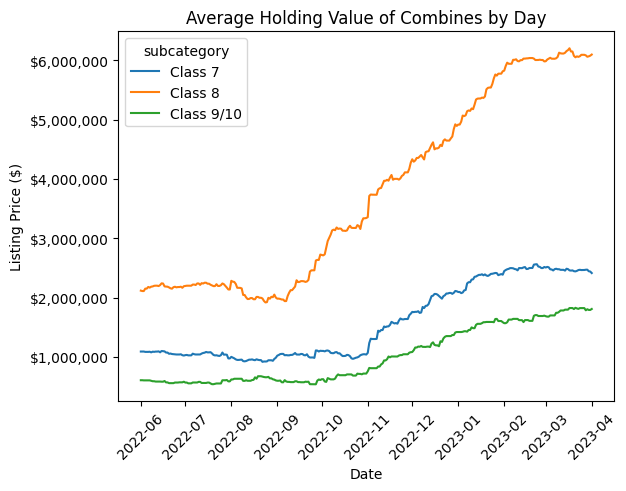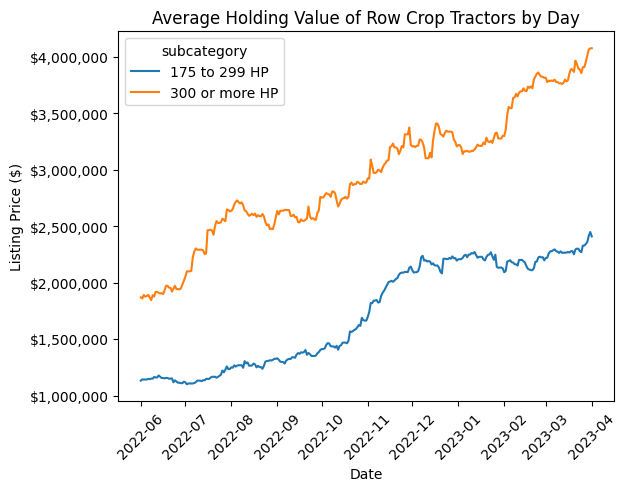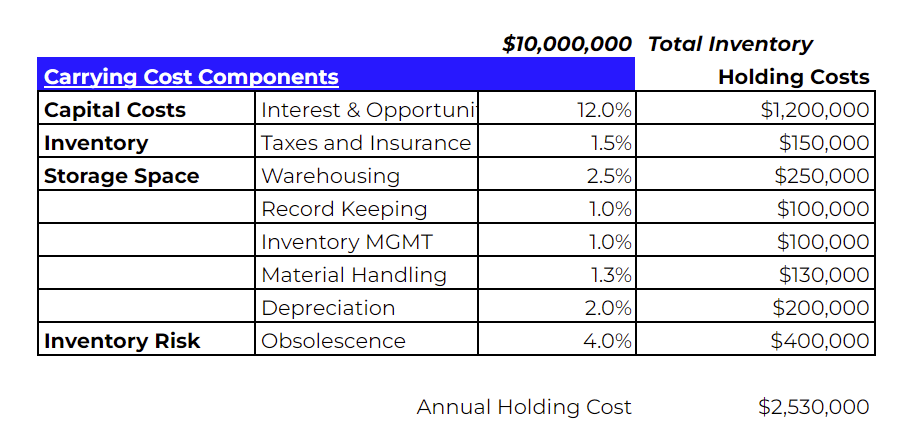Trending Inventory Build-up Risks Profit Erosion
Reprinted with permission from Icon Comps and Tractor Zoom
- Compact and subcompact tractor supply levels have ballooned. Combines are not far behind and now larger tractors may be following suit.
- Tracking important inventory metrics can help control holding costs before they erode a significant portion of your dealership's profits.
- Understanding the components of holding costs allows a dealership to know which levers to pull to control their costs.
- Read how other dealerships are tracking and managing their inventory to reduce risky inventory, and improve margin and turns.
The Inventory Challenge
- Capital Costs. This includes the most obvious interest expense, but also covers the opportunity cost of what else you could be doing with your money.
- Storage. Even if you currently have plenty of room in your lot, you are still insuring all your equipment, right? Is it depreciating? Do you have to spend money on having your crew move it around and maintain it? All of this wraps into your storage costs.
- Service. Taxes and insurance are the most common examples of inventory services costs.
- Risk. The more assets you have on your lot, the more you are at risk of losing something. Whether it is theft (shrink), depreciation, or worse… it becomes obsolete! More than likely obsolescence isn’t going to happen immediately, but just think of the rate of new technology being introduced. How long will it take for a farmer to look past your older model because it doesn’t have that new shiny feature? As far as depreciation goes, we can tell you from our Tractor Zoom analysis that usage, in hours, is the largest depreciating factor. Age is second.
Not all equipment is the same, I get it. You can throw a rock picker out in the back lot for a year and not cover it with insurance, it’s not going to be one-upped by a new model anytime soon, and a numbskull is not going to drive off with it (hopefully?). That is why calculating your holding costs by category is vital. Some categories, like those with drivetrains and tech, are going to have a much higher holding cost as a percentage of their value.
Inventory Trends and Costs
Let’s start with what we know. Smaller tractors, like every other equipment category, were backlogged all the way from the chip manufacturers overseas, to the ports off California, to the mess that was our trucking industry, to the labor constrained manufacturing floor. Calling it a mess is putting it lightly. But humans are great problem solvers, and smaller problems are easier to solve than bigger problems. Plus, add a huge carrot in front of small tractor manufacturers in the form of huge pandemic-inflamed hobbyist demand, and it is not hard to see why so many manufacturers prioritized pumping out tractors with less than 100 horsepower. The big problem here was that there was such a huge immediate demand coinciding with a building production behind a pinched off pipe. When that pinched pipe was released this past year, truckloads of tractors flooded the market. There likely wasn’t going to be enough demand to soak them all up anyway, but when you add significantly higher interest rates to this concoction, demand starts to look more like attendance in my 8 AM Friday morning college classes.
Subcompact and Compact Tractors
So what does this small tractor segment look like?

The trend is consistent across the board for smaller tractors at these dealerships. Average dealership’s inventory values are drifting towards a 100% increase for these tractors in one year’s time.
Combines
Combines are highly seasonal and were not nearly as easy to ramp up production at the manufacturers as subcompacts were. Plus combine customers are almost entirely different buyers, yet farmers are still being pinched by high interest rates just like acreage owners. While acreage owners are being forced to trade their tractor seats for office chairs, grain farmers have the current pressure that is the crumbling commodity markets. At the time of this writing, corn is $2 off its high and wheat can only be described as a head spinning spiral between bad to horrible. Below you can see the change in average holding value of combines at a dealership across the same 39 dealerships in this study.

Row Crop Tractors
Not all dealerships are carrying a scary level of combines, while other dealerships do not have a significant proportion of compact tractors. Yet row crop tractors do typically make up a weighty amount of the total assets at many dealerships. Supply has not returned to this category as fast as the others mentioned above, but the data is pointing in that direction.

The holding value has approximately doubled over the past year. No metric should be considered in isolation and without context. So here is that context. New supply is still moving off the lots at a decent clip. There has been, and still is, backed up demand from farmers, and that shows when we analyze the Iron Comps data to determine the growth of Months of Supply. Months of supply is calculated by dividing the current inventory advertised by that month's sales volume.
Last April the average months of supply of Row Crop Tractors was three months. After peaking at almost five last summer and dipping in December, it is back up to four months of supply this April, an increase of 33%. So increasing, but not to the extent of combines or smaller tractors.
How Much Does This Holding Value Actually Matter?
1.5% is estimated for taxes and insurance, although taxes are dependent on your state’s tax laws. The storage space costs are variable from dealership to dealership. One good way to make an estimation here is to look at your books and ask “What costs would be eliminated if you carried no inventory?” and “What costs would be cut in half if you cut your inventory levels in half?” The answers here should provide a good indication of your storage space percentages. While upside down the last couple of years, depreciation is directly correlated with inventory value, and will start to play its typical tune going forward.
Calculating Holding Costs
For every $10 million in annual inventory your dealership is carrying, your true holding cost could be as large as $2.5 million.

It’s understandable if your dealership is not measuring all these factors into your costs. If your dealership is established, the likelihood you are going to cash it all in for the opportunity of a CD sits down there on the decision ladder next to insane. A conservative estimation though should still include at least the following, which still equates to over $1 million dollars.

Solutions
"What gets measured, gets managed" -- Peter Drucker
- Gain Consensus: The first essential step is to gain consensus at your dealership about what will be used to calculate your holding cost, monitor it frequently (and automatically if possible) then make that measurement publicly available. At some level your dealership requires inventory. You don’t want to run into a scenario where your sales team cuts deals just to eliminate inventory. This is where category and even model specific monitoring can be key if you are watching the market for hot spots. Some categories are less likely to accumulate holding costs than others. Equipment that are at high risk for obsolescence, depreciation, insurance, and have higher value increase your holding costs. (Class 8 combines…?)
- Increase Visibility: So how does one actually get ahead of this market? If we all could see the future, we would likely not be sitting where we are. You need visibility into how the market is performing compared to your pricing, and then an efficient process to act on those insights. While we cannot perfectly predict the future, now in the digital age you can have instance access and response to it.
- Make Actionable: Of course, almost everything is easier said than done. If you are anything like my students, adding in another system or program to check doesn’t go over well. My students struggled to adopt a new homework software system until we discovered it integrated with email. What was once ‘one more thing to check’, simply became responding to their email, which they were already adept at doing. “Insights to Action” is the name of the game. Data is great, but only if it helps you reach your goal. You can watch a video about it here, or read here how another dealership has benefited from active inventory management.
Whatever system you use to monitor and manage your inventory levels, make sure you are accounting for the full holding cost to your dealership, especially now as we enter a new phase in the ag economy.
Check out our other appraisal resources and find your local appraiser.